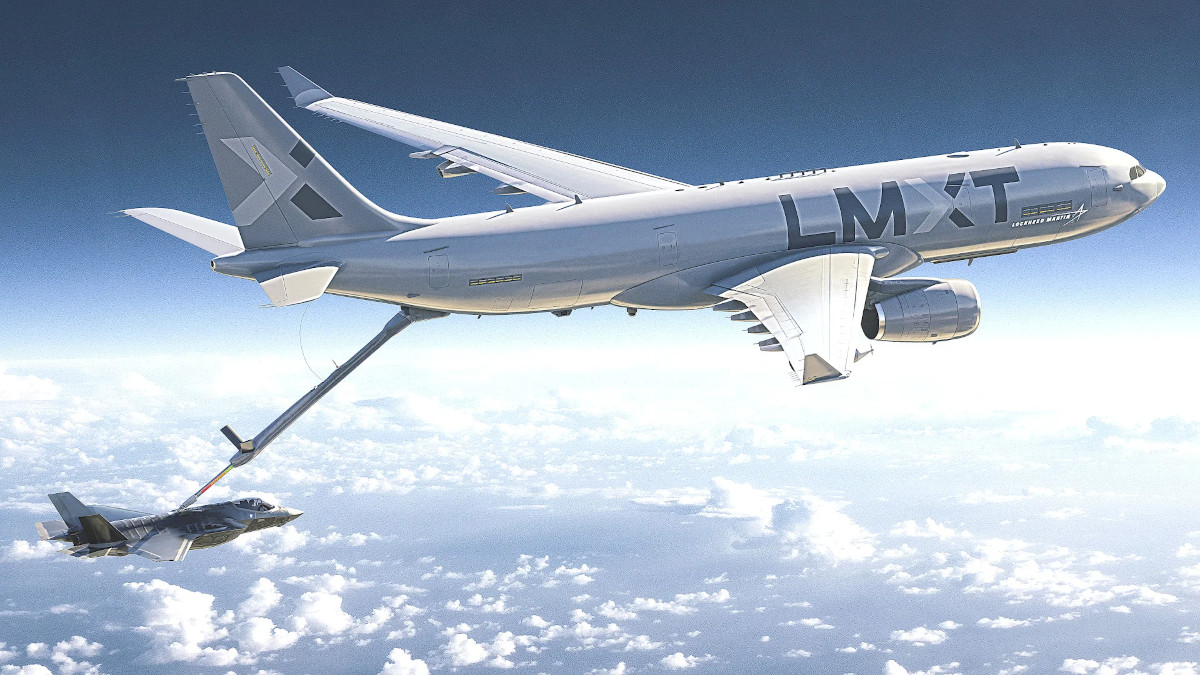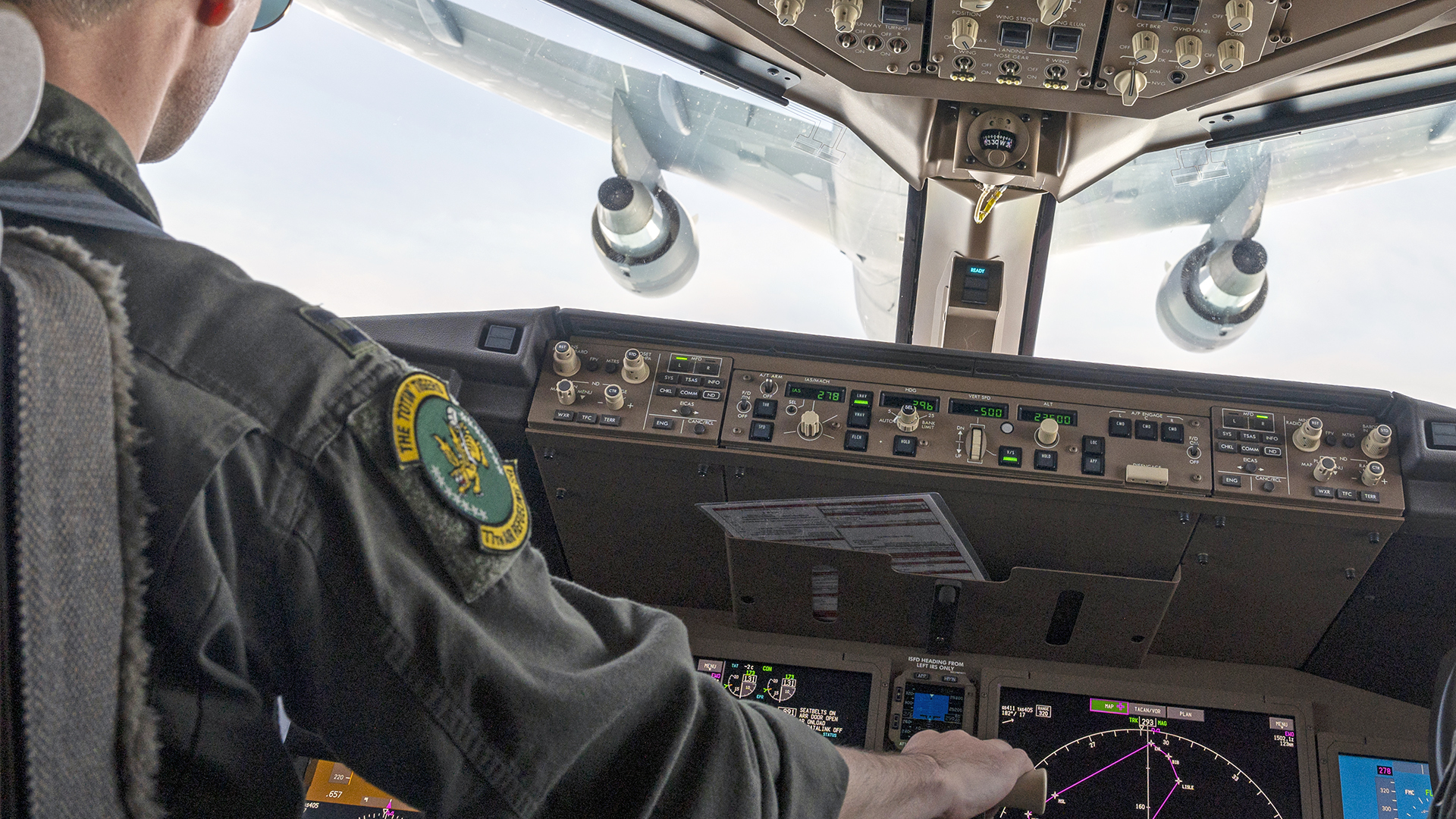The U.S. Air Force is exploring the possibility of allowing KC-46A Pegasus aerial refueling tankers to fly with just two individuals on board – a pilot and a boom operator – in certain high-end wartime scenarios, such as a future conflict against China. These tankers are currently not available to support combat operations of any kind, except in emergency circumstances. News of the plan has already prompted intense discussion, as well as criticism, online about potential safety concerns as a product of the increased workload on such a skeleton crew.
Air Force Maj. Hope Cronin, a spokesperson for Air Mobility Command (AMC), which oversees the bulk of the service’s aerial refueling tanker fleets, has confirmed to The War Zone that officials at McConnell Air Force Base in Kansas have submitted a request for a waiver to allow two-crew KC-46A operations. Typically, tankers will fly with a minimum of a pilot, co-pilot, and boom operator. As of May, the Air Force had received 59 Pegasus tankers, with more than 20 of those having gone to units at McConnell.

The first information about the waiver had appeared on unofficial Air Force social media channels, such as the Air Force amn/nco/snco Facebook page and the r/AirForce Subreddit, on July 15. The anonymous source for this initial information claimed that AMC commander Gen. Michael Minihan had received this request and was considering it due to concerns about recruitment and retention at McConnell, something the command has denied. The Air Force, overall, is experiencing a pilot shortage at present, something that has been an issue in the past and that the service had been making some minor progress in recent years to reverse. The post-pandemic boom in air travel and hiring by the airlines could see the situation worsen once again in the future.
“AMC is moving forward faster in a risk-informed manner to ensure Mobility Air Forces are ready to be the meaningful maneuver force required to meet Joint Force needs in a peer competitor fight. Mobility aircraft typically fly with a pilot, co-pilot, and based on aircraft type, a loadmaster and/or a boom operator,” Maj. Cronin, the AMC spokesperson, told The War Zone. “The command is currently reassessing minimum flight crew requirements as we explore and validate new tactics, techniques and procedures (TTPs) oriented towards a dynamic, future fight.”
“The waiver request in question is part of the process to safely validate exploratory TTPs that are being assessed in training simulations and concept of employment development for potential use in a hypothetical peer competitor fight,” she continued. “The AMC staff is currently reviewing this concept development and ensuring the authorities to execute this type of maneuver are at the MAJCOM [major command] level and can be executed within an adequate safety margin before approval will be provided.”

The War Zone has reached out to AMC to find out whether similar TTPs have been approved or are now being considered for use with the Air Force’s KC-135 or KC-10 tankers. The KC-135 and KC-10 are both much older designs than the KC-46, and have far more limited degrees of automation, which could limit any potential ability to operate with reduced crews. It is also important to note that there is no indication, even if the two-crew option for the KC-46 is approved, that it would ever be authorized for routine, day-to-day use.
Being able to fly KC-46As with just two crew members could possibly be useful in a large-scale conflict situation where the demand for aerial refueling sorties will be very high, but the total number of available tankers may be low, including due to losses from enemy action. In recent years, the Air Force has made no secret about its desire for more tanker capacity and concerns about the vulnerability of these aircraft in a high-end fight. It’s important to remember that KC-46As are also capable of carrying out cargo and passenger-carrying and aeromedical evacuation missions, which will only add complexity to mission planning and tasking processes during a major conflict.
At the same time, as many commenters on social media, including current and former Air Force personnel, have already noted, the idea of attempting to operate a KC-46A, or any other tanker, with just two crew members can only prompt questions about safety and the general strain put on those individuals. Aerial refueling is an often complex and potentially dangerous task, especially during major combat operations, requiring significant communication and coordination between members of the tanker’s crew, and between individuals on that aircraft and the one receiving the gas, especially during major combat operations.
With only a single pilot and boom operator, a KC-46A would have no backup personnel to perform a host of critical functions should either one of those individuals be incapacitated for any reason, including unexpected medical emergencies, during a mission. Impacts on other basic quality of life issues, including just needing to do things like eat, sleep, and go to the bathroom, would be exacerbated by having no alternate crew members on the aircraft.
There is a reason why the U.S. Federal Aviation Administration (FAA) places restrictions on what kinds of private and commercial aircraft can be flown with just one pilot and when – certain light jets and smaller aircraft only, and even then only under certain circumstances – and those flights can generally be expected to be far less demanding than operating a tanker on a potentially long-duration sortie in a conflict zone. Nowhere in the world are commercial jets of a similar size to the KC-46 allowed to fly with just one pilot.
Robert Hopkins, an aviation historian, author, and contributor to The War Zone, who flew C-135s variants, among other aircraft, during his tenure with the Air Force, further highlighted on Twitter how this two-crew concept seemed to both acknowledge the vulnerabilities of traditional tankers and offer as a solution simply putting more of them in harm’s way. It would certainly look like the service is very much planning around the expectation that it will lose a significant number of tankers in any future high-end fight, if nothing else.
In principle, the more automated systems found on the KC-46A could alleviate or mitigate some of those concerns. Pegasus tankers with two-person crews might potentially be assigned to lower-risk environments in the context of a broader conflict, as well. However, the Air Force’s Pegasus fleet has been plagued by persistent and serious issues, especially with the aircraft’s refueling boom and the Remote Vision System (RVS) that operators use to guide it into receiving aircraft, as you can read more about here.

So serious are these problems that “we currently stop short of full combatant command deployments [involving KC-46As], barring emergency need,” AMC spokesperson Maj. Cronin told The War Zone last month.
As it stands now, the Air Force does not expect to achieve a real initial operational capability (IOC) with the KC-46A until 2024 at the very earliest, when the fix for the RVS is expected to be finalized. Given the extent of the modifications to the RVS and the boom that will need to be integrated into the entire fleet, that timeline is likely optimistic. How the final operational configuration of the Pegasus may impact the Air Force’s decision about operating these jets with only two crew members remains to be seen.
All of this also comes at a time when the Air Force is reassessing its plans for acquiring additional new tankers. The service’s top leadership, particularly Secretary of the Air Force Frank Kendall, has made clear they are strongly considering axing previously announced plans for a new tanker competition. Last year, the Air Force Life Cycle Management Center said it would be looking at multiple designs when considering how to “bridge the gap” between the end of the currently expected purchases of KC-46As, 179 in total, and the acquisition of a still notional future advanced tanker, commonly referred to as KC-Z. The Air Force still has yet to finalize its requirements for KC-Z, but stealthy and unmanned platforms have been put forward as possible options in the past.
In terms of the bridge tanker plan, Lockheed Martin subsequently announced it had partnered up with Airbus to offer a new U.S.-specific configuration of the popular A330 Multi-Role Tanker Transport (MRTT) called the LMXT, as an alternative to the Pegasus. Versions of the A330 MRTT have been pitched to the Air Force on multiple occasions before, including in the competition that led to the selection of the KC-46A.

Altogether, it very much remains to be seen how the Air Force ultimately implements a two-crew concept for the KC-46A, if at all, and under what circumstances the aircraft might actually be authorized to fly with only two individuals onboard.
Contact the author: joe@thedrive.com
